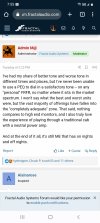macfly
Inspired
Oh LOL. No I'm just using mon 1 most of the time, and what I was referring to was mon 2, sorry for the mistake re: its actual eq. With my presets it sounds less like a PA speaker...i'd guess because alot of the speakers we play through are more smiley face eqs? I never looked at the manual to see what each one was...I just know that 90% of the time the first one sounds great and if it's too bright, I go to the next one. I think I tried GUITARCAB early on and didn't like it.That's not what Monitor 2 mode is... It's actually the flattest EQ.
There's is a mode called "GUITARCAB" which is probably what you're referring to?
Interesting tho that you've prompted me to go read the manual. It says mon 2 is a "Secondary preset with more LF boost." It sounds more like your description but anyway. Whatever it is...1 and 2 work for me. Thanks for letting me know tho!!!
Last edited:



